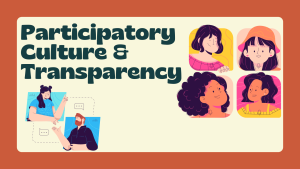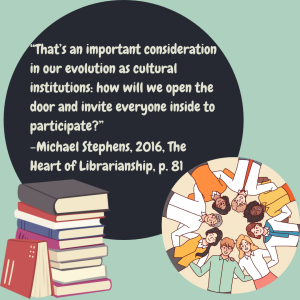For this assignment, I wanted to focus on participatory service/culture and transparency. What does it mean for the community? What does it mean for the library?

Per Casey and Savastinuk (2007), participatory service means having mechanisms in “our structures through which both users and nonusers can participate in the service creation process” (p. 62). There needs to be a horizontal flow of ideas, rather than top-down. For the community (whether they are active patrons or not), this means that their voice can be heard in relation to programs and services that the libraries offer. For the libraries, it means that they are able to get almost instantaneous feedback about their community’s needs (if they take advantage of – and they should – the internet and social media).
In order for participatory service to work, however, there has to be trust between the library and community. When libraries earn the community’s trust, there are a myriad of benefits: “trust breeds loyalty,” loyal patrons are more likely to use the library more, and are more likely “to sing the praises of the library to neighbors and colleagues” (Schmidt, 2013).
One of the best ways to build trust is to be transparent with the community. As @michael (2016) aptly states, “The era of participatory culture demands that cultural and information professionals play an active, visible role in our communities” (p. 80). This means providing more library access to the community. Luckily, this does not have to be difficult to start. This is where the hyperlinked library can come into play and communities can connect with their libraries not only in person but also online. For example, the Waterboro Public Library (in East Waterboro, Maine) created blogs that allowed patrons to leave comments about their thoughts on library events and services (Casey & Savastinuk, 2007). While this no longer seems to be active, they do still have a Facebook page that is active and allows comments on posts. Having that online communication channel, whether through social media or blogs, can make a huge difference.
Libraries also have to break down barriers that prevent community members from making the most of their libraries. This is particularly true in a financial sense. One major barrier for some people are fines and fees. (I have actually heard people say before that they do not really use the library anymore because they are afraid of how much they owe from overdue fines!) Luckily, many libraries have been eliminating some of these financial barriers. In a 2022 Library Journal survey, they noted that U.S. public libraries that charged patrons overdue fines dropped from 92 to 36 percent (Gerber, 2022). In fact, the survey respondents stated that it led “to increases in patron satisfaction and participation and to staff morale” (Gerber, 2022).
Most importantly, when it comes to participatory service, libraries have to be open to change when there is feedback from the community. Because libraries are cultural institutions, they should reflect the communities they serve. This is something that I will continue to keep in mind while working at a public library. There has to be radical trust between community members and me (their librarian). Because, if they cannot trust me or any other fellow library aide, how will they be able to trust their library as an institution that is made for them? I also have to learn how to advocate for transparency and breaking down barriers for the community if management is unwilling to listen. Our communities are made up of people and it is our job as information professionals to lead with empathy and understanding of their needs. We always have to keep asking: how can we work with and listen to our communities to provide the best and most appropriate services that they need and want? Libraries are not about books or computers. They are about people.

References
Casey, M. E., & Savastinuk, L. C. (2007). Library 2.0: a guide to participatory library service. Information Today.
Gerber, A. (2022, September 28). LJ’s 2022 fines and fees survey shows a transformed landscape since 2017. Library Journal. https://www.libraryjournal.com/story/Fine-Farewells-LJs-2022-Fines-and-Fees-Survey
Schmidt, A. (2013, November 5). The user experience: Earning trust. Library Journal.https://www.libraryjournal.com/story/earning-trust-the-user-experience
Stephens, M. (2016). The Heart of Librarianship. American Library Association.
Hi Esperanza!
Thank you for sharing your thoughts on participatory service and community in the library! I loved how you discussed the concept of radical trust and how in order for participatory service to work – there needs to be an establishment of trust between libraries and their users!
I’m glad that overdue fines are becoming a thing of the past – the library I am currently at only charges for lost or damaged items. And the awesome thing is if the lost item is returned that charge disappears from the patron’s account!
I think you will be a very kind and community forward librarian.
Hi Ashley,
I appreciate the kind words! I hope that if we (information professionals) all move towards being more empathetic. It won’t always be easy but it will definitely be worth it!
Hey @ashleyho and Esperanza!
I agree with you completely–there cannot be any hope of success without radical trust. It truly is the bedrock of a society, a library, any organization, really–and if we can model that at our libraries I would hope that it would eventually seep out into the wider world. Sounds cheesy, but I think that’s right. That trust has to move in both directions to be foundational–not only do patrons need to trust the library and librarians, but librarians and library systems must trust their patrons. I think this can be very scary for some people–especially patron to patron trust–which is one reason that we’ve seen a breakdown of that faith in libraries of late (book banning, civil actions against librarians etc.). Putting up barriers out of fear of what someone else *might* do is the antithesis of what we’re trying to accomplish over here!
All the best,
Mei
Hi @meic,
That is a great point that librarians also need to trust their patrons. Like you mentioned, it can be scary, but trust needs to go both ways!